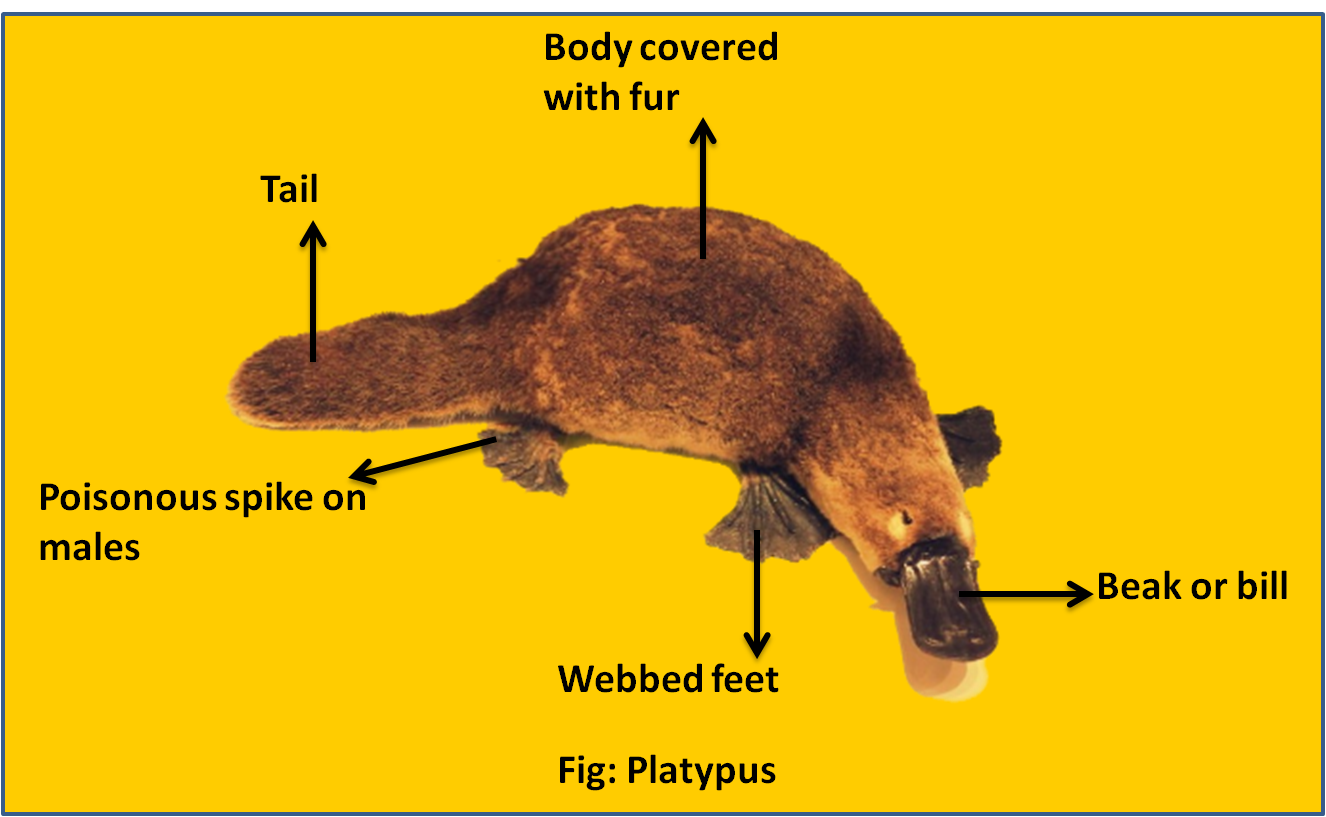
Which of the following animals is not viviparous?
(a) Platypus
(b) Whale
(c) Flying fox (Bat)
(d) Elephant
Answer
474.3k+ views
Hint: This is one of the world’s most evolutionarily distinct mammals, one of five extant species of egg- laying mammals, and the only living species within the subclass Monotremata and the only living species within the family Ornithorhynchidae.
Complete step by step answer:
Platypus is, however, true mammals because they elaborate posh milk under the control of equivalent hormones that control lactation in both other groups of mammals. The most characteristic feature of monotremes is that they lay eggs. This is not to say that the embryo is not nourished in the uterus and they have an allantois and yolk sac placenta. The egg is laid when the embryo has reached the 19-20 somite stage, and within the echidna, but not the platypus, a pouch develops to receive the egg.

So, the correct answer is, ‘Platypus.’
Additional information:
- As one among the world’s most evolutionarily distinct mammals, the platypus has long been regarded to be of outstanding scientific importance also as a globally unique component of Australia’s biodiversity.
- The young are dependent on milk for the first few months of life to sustain its development.
- In platypus, like all other mammals, the milk is produced by well- developed mammary glands.
- Unlike all other mammals, the feminine s haven't any nipples and therefore the milk is expressed by the female from two teatless areolae and the young suck the milk directly from the abdominal surface.
- Monotreme milk composition, is similar to that of marsupials, changes throughout lactation and therefore the composition of platypus and echidna milk differ significantly.
- Most organ systems are known to differentiate during pouch or nest life although much less is understood about this process than in marsupials.
- The platypus karyotype consists of 52 chromosomes in both sexes and includes six pairs of huge autosomes, an outsized X chromosome, 17 pairs of smaller chromosomes that are hard to differentiate and four small elements with no pair.
Note:
- Two unique features of monotremes are the development of an electro- sensory mechanism in their snouts that assists them to locate their invertebrate prey and the presence in males of a keratinous canalized spur which are connected by a skinny membranous duct to an associated venom gland.
- In the platypus, the venom system is well developed and which are capable during the breeding season of inflicting wounds, but not apparently death, during territorial fighting between males.
Complete step by step answer:
Platypus is, however, true mammals because they elaborate posh milk under the control of equivalent hormones that control lactation in both other groups of mammals. The most characteristic feature of monotremes is that they lay eggs. This is not to say that the embryo is not nourished in the uterus and they have an allantois and yolk sac placenta. The egg is laid when the embryo has reached the 19-20 somite stage, and within the echidna, but not the platypus, a pouch develops to receive the egg.

So, the correct answer is, ‘Platypus.’
Additional information:
- As one among the world’s most evolutionarily distinct mammals, the platypus has long been regarded to be of outstanding scientific importance also as a globally unique component of Australia’s biodiversity.
- The young are dependent on milk for the first few months of life to sustain its development.
- In platypus, like all other mammals, the milk is produced by well- developed mammary glands.
- Unlike all other mammals, the feminine s haven't any nipples and therefore the milk is expressed by the female from two teatless areolae and the young suck the milk directly from the abdominal surface.
- Monotreme milk composition, is similar to that of marsupials, changes throughout lactation and therefore the composition of platypus and echidna milk differ significantly.
- Most organ systems are known to differentiate during pouch or nest life although much less is understood about this process than in marsupials.
- The platypus karyotype consists of 52 chromosomes in both sexes and includes six pairs of huge autosomes, an outsized X chromosome, 17 pairs of smaller chromosomes that are hard to differentiate and four small elements with no pair.
Note:
- Two unique features of monotremes are the development of an electro- sensory mechanism in their snouts that assists them to locate their invertebrate prey and the presence in males of a keratinous canalized spur which are connected by a skinny membranous duct to an associated venom gland.
- In the platypus, the venom system is well developed and which are capable during the breeding season of inflicting wounds, but not apparently death, during territorial fighting between males.
Recently Updated Pages
Master Class 11 Accountancy: Engaging Questions & Answers for Success

Express the following as a fraction and simplify a class 7 maths CBSE

The length and width of a rectangle are in ratio of class 7 maths CBSE

The ratio of the income to the expenditure of a family class 7 maths CBSE

How do you write 025 million in scientific notatio class 7 maths CBSE

How do you convert 295 meters per second to kilometers class 7 maths CBSE

Trending doubts
10 examples of friction in our daily life

One Metric ton is equal to kg A 10000 B 1000 C 100 class 11 physics CBSE

Difference Between Prokaryotic Cells and Eukaryotic Cells

State and prove Bernoullis theorem class 11 physics CBSE

What organs are located on the left side of your body class 11 biology CBSE

Write down 5 differences between Ntype and Ptype s class 11 physics CBSE




